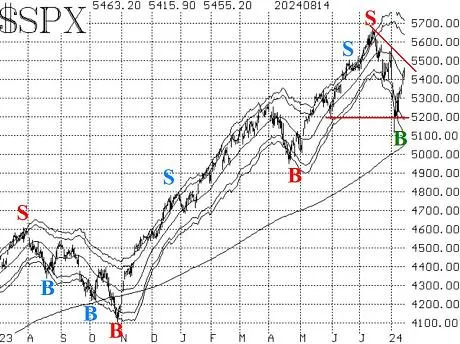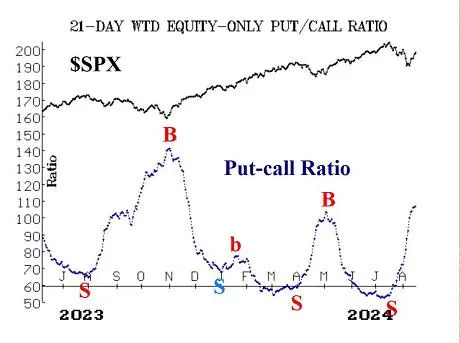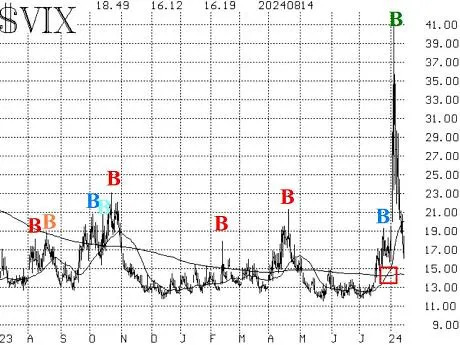
The S&P 500 SPX has recovered swiftly since the lows of Aug. 5. The question remains, though, as to whether this is merely an oversold rally — temporary enthusiasm that will fade — or the beginning of the next leg upward in an ongoing bull market.
Typically, oversold rallies rise to the market’s declining 20-day moving average (MA) and perhaps exceed it by a small amount. Then the market slips again. The current rally exceeded its declining 20-day MA on Aug. 13. It also closed a gap on the SPX chart at 5,410. There is a downtrend line connecting the lower highs on the accompanying SPX chart. That downtrend line is slightly below 5,500 currently.
If this is merely an oversold rally, it has about reached the extent of its ascent. However, if that downtrend line is broken and SPX exceeds 5,500 — and especially if it exceeds the Aug. 1 peak at 5,570 (which would break the pattern of lower highs) — that would suggest that the recent sharp decline has merely been a correction in an ongoing bull market.

The McMillan Volatility Band (MVB) buy signal of Aug. 9 is still in effect. Its target is the +4σ Band, which is currently just above 5,700 and declining. In fact, all of the “modified Bollinger Bands” (mBB) are descending now, as are the shorter-term moving averages. The MVB buy signal would be stopped out if SPX were to close below the -4σ Band, which is at 5,100 and declining. So, SPX is not remotely near either of the +/-4σ Bands at this time.
Equity-only put-call ratios remain on sell signals for the stock market. They will continue to do so as long as they are rising — which they have been doing even during this strong rally that has taken place over the last 10 days or so.


Market breadth has been mixed, although NYSE breadth has consistently been better than “stocks only” breadth since late July. Currently, both breadth oscillators are on buy signals. The NYSE oscillator has almost reached overbought territory already, but the “stocks only” oscillator is far from that status.
New highs on the NYSE numbered more than 100 yesterday (and outnumbered new lows) for the first time since the broad market selloff began. If that condition repeats itself today, this indicator will generate a new buy signal.
Realized volatility, measured as the 20-day historical volatility of SPX (HV20), remains at an elevated level of 22%. This indicator gave a sell signal some time ago, when HV20 crossed above 10%. For now, this is still a bearish indicator, but if it were to fall back to 15%, the danger will have passed.
Implied volatility VIX continues to give mixed signals. The most recent “spike peak” buy signal of Aug. 5 remains in place. However, the trend of VIX sell signal is also at work. The latter would be stopped out if VIX were to close below its 200-day MA — which is currently at 14.50 and rising slowly. VIX is down to 15.60 or so and moving lower, so that sell signal could be stopped out in the relatively short term.

One thing that has remained bearish is the construct of volatility derivatives. That is, the term structures — particularly that of VIX futures — have continued to slope downward. The front-month August VIX futures have consistently been trading at higher prices than September VIX futures, and VIX futures have been trading at a discount to VIX.
These conditions have abated somewhat over the past couple of days, but they have persisted. In the 20 years that VIX futures have been trading, this has generally been an extremely negative sign for the stock market. These worrisome conditions would be removed if the term structure returned to an upward-sloping one once again.
In summary, we have traded the confirmed signals that have occurred, and we have rolled positions that became deeply in-the-money.
New recommendation: Potential ‘new highs vs. new lows’ buy signal
There were more than 100 new highs on the NYSE on Aug. 14. If this continues on Aug. 15, which seems almost certain, then this indicator will generate a new buy signal.
Since the number of new highs cannot decrease during the day, you can keep an eye on that figure throughout the day, and if it reaches 100 then buy the spread. If the spread is established, then it would be stopped out if, at a later date, NYSE new lows exceed new highs for two consecutive days.
New recommendation: Chipotle Mexican Grill (CMG)
A new weighted put-call ratio buy signal has been issued for CMG CMG. The stock fell sharply on Aug. 13 after news that the CEO was leaving to go to Starbucks SBUX. If CMG trades higher into the gap that was left by that news, we are going to act on the put-call ratio buy signal.
If CMG closes above $52.30, then buy 3 CMG (Sept. 27) 52 calls in line with the market.

New recommendation: Walgreens Boots Alliance (WBA)
This a longer-term potential buy signal from Walgreens Boots Alliance WBA. We are keeping this recommendation open but will not continue to reprint the reasoning behind the trade, other than to say that stocks that have been removed from the Dow Jones Industrial Average DJIA usually experience a strong rally within a matter of weeks after that removal.
WBA was obliterated after its latest earnings report. The potential MVB buy signal was canceled. So, we adjusted our entry points:
If WBA closes above $13.10, then buy 2 WBA (Aug. 30) 13 calls in line with the market. (Note change in expiration date)
Follow-up actions:
We are using a “standard” rolling procedure for our SPY spreads: In any vertical bull or bear spread, if the underlying hits the short strike, then roll the entire spread. That would be roll up in the case of a call bull spread or roll down in the case of a bear put spread. Stay in the same expiration and keep the distance between the strikes the same unless otherwise instructed.
Long 2 FIVE FIVE (Sept. 20) 65 puts: We are holding without a stop for now.
Long 2 AKAM AKAM This position will be held as long as the AKAM weighted put-call ratio remains on a buy signal. These calls were rolled up on Aug. 9, when AKAM traded at 100.
Long 1 expiring UNP UNP Sell this call and do not replace it.
Long 2 RHI RHI (Sept. 20) 65 calls: We will hold these as long as the weighted put-call ratio of RHI remains on a buy signal.
This spread was bought in line with the equity-only put-call ratio sell signals. We will hold until those ratios roll back over to buy signals.
This put spread is based on the trend of VIX sell signal, and would be stopped out if VIX closes below its 200-day MA.
Long 2 COO COOWe will hold this position as long as the weighted put-call ratio for COO remains on a buy signal.
This was bought when VIX closed back below VIX3M on Aug. 8. It was designed to last five trading days, so the spread should be closed today, Aug. 15. Technically, by our rules for trading a bull spread, the spread should be rolled up if SPY trades at 545. In reality, since this is the last day this position is going to be held, it should be merely be sold if SPY trades at 545 — and not replaced.
This spread was taken in line with the VIX “spike peak” buy signal. Roll the spread up 20 points on each side. It will be held for 22 trading days.
Send questions to: lmcmillan@optionstrategist.com .
Lawrence G. McMillan is president of McMillan Analysis, a registered investment and commodity trading advisor. McMillan may hold positions in securities recommended in this report, both personally and in client accounts. He is an experienced trader and money manager and is the author of Options As A Strategic Investment.
©McMillan Analysis Corporation is registered with the SEC as an investment advisor and with the CFTC as a commodity trading advisor. The information in this newsletter has been carefully compiled from sources believed to be reliable, but accuracy and completeness are not guaranteed. The officers or directors of McMillan Analysis Corporation, or accounts managed by such persons may have positions in the securities recommended in the advisory.





